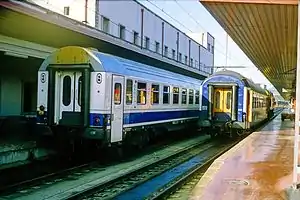Through coach
In rail terminology, a through coach is a passenger car (coach) that is re-marshalled during the course of its journey. It begins the journey attached to one train, and arrives at its destination attached to another train.[1]

Through coaches save their transit passengers the need to change trains themselves.[1] They also increase the number of direct links offered by the train operator(s).
Most frequently in the form of sleeping or couchette cars, through coaches have commonly been used for long-distance journeys, especially in continental Europe, although they are much less common now than they were in the early 1970s.
Example
In 2010 and 2011, the Basel – Moscow sleeping car (2,856 km or 1,775 mi in 37 hours and 11 minutes) was attached successively to the following trains:[3][4]
- from Basel SBB to Hannover Hbf: CNL 472 Basel SBB – Copenhagen;
- from Hannover Hbf to Warszawa Wschodnia: EN 447 Amsterdam – Warszawa Wschodnia;
- from Warszawa Wschodnia to Brest: 405 Bohumin – Brest; with bogie exchange at the international border because of a break of gauge from 1,435 mm (4 ft 8+1⁄2 in) standard gauge to 1,520 mm (4 ft 11+27⁄32 in) gauge
- from Brest to Moscow: D 22 Brest – Moscow.
See also
References
- "Railway Operations - I: Train Services – Q. What are 'slip coaches' and 'through coaches'?". irfca.org. IRFCA.org. 2010. Retrieved 30 August 2013.
- DBAG Reservation List
- "Train timetable". RW.by. Retrieved 13 March 2017.